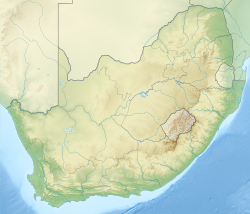
Back Olifantsrivier, Limpopo Afrikaans نهر اوليفانتس ARZ Уліфантс Byelorussian Мпумаланга (рака) BE-X-OLD Олифантс Bulgarian Olifantsrivier (suba sa Limpopo) CEB Lepelle German Río Olifants (Limpopo) Spanish Olifants French Olifants River (Limpopo) Italian
| Olifants River Olifantsrivier, Rio dos Elefantes | |
|---|---|
 Olifants River as it flows through the Kruger National Park | |
 | |
Location of the Olifants-Limpopo confluence | |
| Etymology | Olifant means "elephant" in Afrikaans, Obalule, means "long, stretched-out one" and Lepelle means "slow-flowing" or "distant"[1] |
| Native name |
|
| Location | |
| Country | South Africa and Mozambique |
| Provinces | Mpumalanga, Limpopo and Gaza |
| Physical characteristics | |
| Source | Near Bethal |
| • location | Mpumalanga, South Africa |
| • coordinates | 26°20′33″S 29°49′47″E / 26.34250°S 29.82972°E |
| • elevation | 1,800 m (5,900 ft) |
| Mouth | Limpopo River |
• location | Gaza Province, Mozambique |
• coordinates | 24°6′44″S 32°38′25″E / 24.11222°S 32.64028°E |
| Basin size | 54,570 km2 (21,070 sq mi) |
| Basin features | |
| Tributaries | |
| • left | Letaba River |
| • right | Steelpoort River |
| [2] | |

The Olifants River, Lepelle,[3] iBhalule or Obalule[4] (Afrikaans: Olifantsrivier; Portuguese: Rio dos Elefantes) is a river in South Africa and Mozambique, a tributary of the Limpopo River. It falls into the Drainage Area B of the Drainage basins of South Africa. The historical area of the Pedi people, Sekhukhuneland, is located between the Olifants River and one of its largest tributaries, the Steelpoort River.[5]
- ^ Transvaal Indigenous Place Names Archived 2008-10-31 at the Wayback Machine
- ^ "State of Rivers Report - The Olifants River System". Council for Scientific and Industrial Research. Archived from the original on 2007-07-03. Retrieved 2009-02-19.
- ^ Olifants River now called Lepelle
- ^ Transvaal Indigenous Place Names Archived 2008-10-31 at the Wayback Machine
- ^ "The Ba Pedi". Archived from the original on 2012-03-14. Retrieved 2012-03-14.
